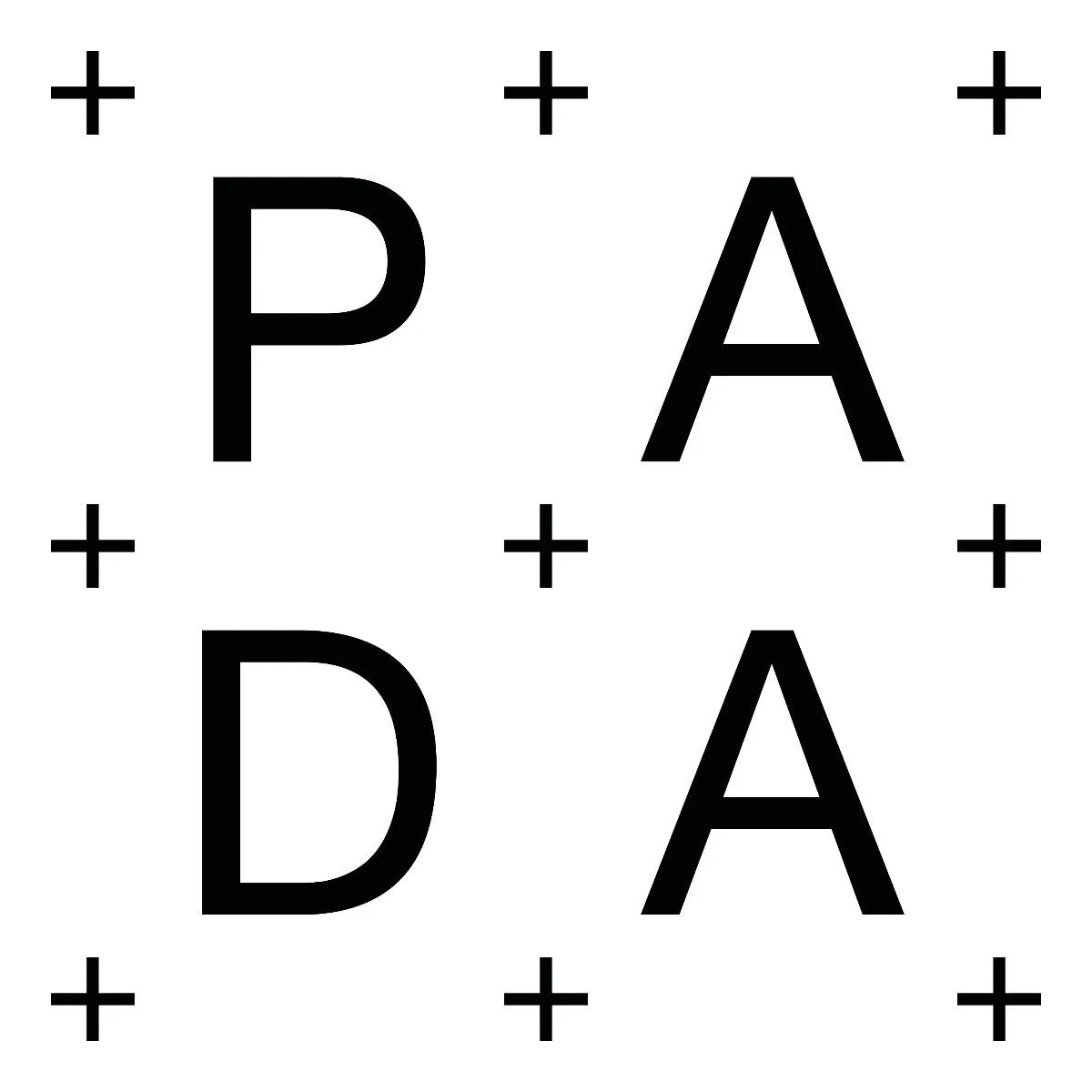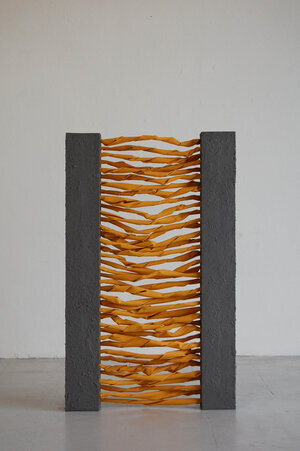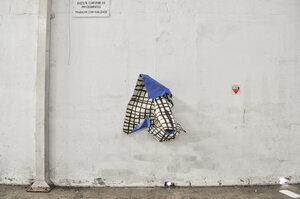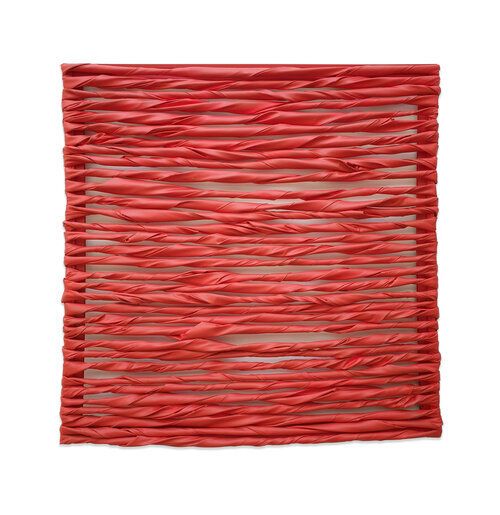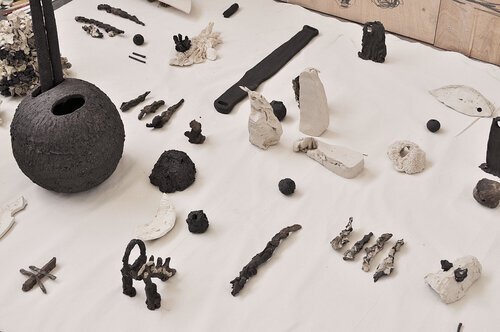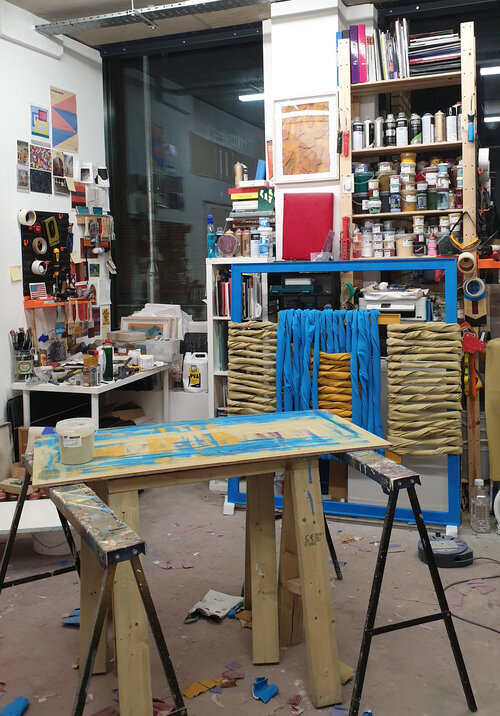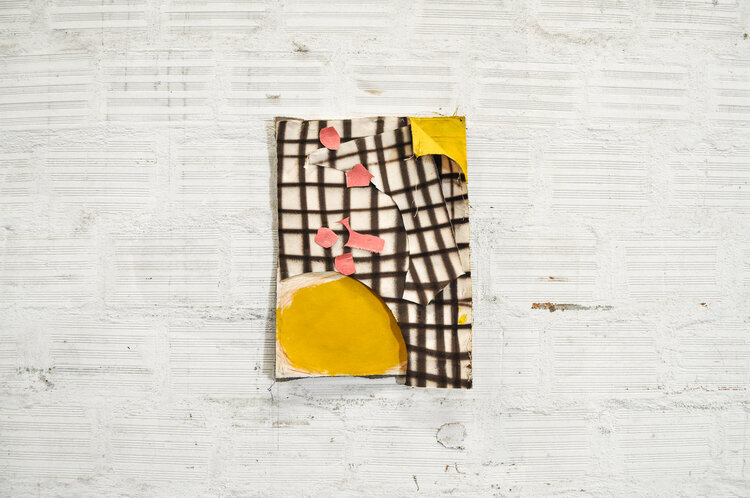LONG RANGE STUDIO VISITS
Bislacchi and Juliette Ezavin
This virtual studio visit brings together two painters who are both consciously working on the boundaries of the medium. They talk about their experiences with PADA, experimentations with materials and possibilities of artistic development during confinement.
Bislacchi, Wall of Canvas 2019 - Acrylic on Wood and Canvas 120 x 72 x 14 cm
At the core of Bislacchi’s practice is an exploration within the confines of the painted canvas support. He is interested in the notion of painting going beyond the two dimensional field where the work addresses issues of space, form and colour. He adapts wooden surfaces that begin as purely functional structures but cease to be supports with the subsequent application of canvas. Consequently, canvas acts as a means to construct the work rather than just being a pictorial support, re-confronting space within the boundaries of painting.
Juliette Ezavin, Moment I, 2019 - Acrylic, spray paint on canvas 120x110cm
Over recent years Juliette Ezavin has been exploring materiality. Currently part of the Turps Studio Programme she has started a body of work questioning the essence of our material surrounding. From the cosmos to the microcosm Juliette endlessly looks closer, researching the construction of mass. Interested in symbiosis in spatiality her works take the form of painting, sculpture and installation for the viewer to experiment with the notions of a system at different levels.
B: Juliette! I’m so delighted to be in conversation with you and to get to know more about your practice. The first time I came across your work was during my residency at PADA last summer. What have you been up to since then?
J: Bislacchi! I am very happy to be in discussion with you. Good eye for the one who paired us! Our work has inherent similarities which I am excited to discuss with you. PADA was pivotal in my life. First I moved on to large scale paintings which was impossible in my studio in London, and secondly it was there that I found out about the Turps Art School. I am delighted today to be part of the ‘Studio Programme’. Run and founded by Marcus Harvey, the art school is based on a strong community of artists working alongside each other in a large open studio layout. I would encourage all painters to look at it.
When I look at your work, I can’t stop myself bouncing between the geometric structure and the organic parts. A sharp dichotomy of ways of working with the material: one is based on a mathematical structure where you predict the outcome and the second one is the torn canvas which seems to follow the shape it wants to take. How much control do you think you have on these shapes? How much do you leave to chance?
Juliette Ezavin, "Cougar" 2000mm x 1200mm, mix media on canvas
B: PADA is a wonderful place for artists looking for opportunities. It has been very important for me also as it gave me the chance to discover a new approach that increased my interest in materiality and construction. My process relies on careful planning before beginning production, therefore I might agree with you, the compositions and structures give a strong sense of control. However, in regard to the canvas that I use, I don’t think I have full control over it. It’s actually the opposite because the shapes that I create by scrunching and twisting the material are given by the limits of the malleability of the canvas itself. Once this limit has been reached, what I do afterwards is just arranging these pieces together within the painting in order to create a consistent body. For instance, the series “Wall of Canvas” that I developed after PADA features pieces of hand twisted canvas stretched over conventional painting supports, reminiscent of a wall structure.
The work you made at PADA displays a similar interest. How has your work developed since?
Bislacchi, Wall of Canvas (Shock Red) 2020 - Acrylic and Spray Paint on Canvas and Stretcher 150 x 150 x 7 cm
J: Interesting, interesting. The notion of pushing the boundary of a common material, such as canvas, to the brink of its limit to see how the meaning has changed is interesting. Converging the control of the artist with the limit of the materiality. The resulting artwork is where the questioning starts... How much of the upstream planning is being transposed in the final piece? When does the material pushed to its limit start being something else?
Materiality is the constant in my work. Chronologically, I can see the subject matter evolving in my work from a compositional arrangement to a work driven by the essence of the materiality. Questioning how the canvas would react with the rigidity of paint, with gravity once stapled by only two points and which new narrative will be created once put in situ. Since, I have been working on ceramics. They are raw smooth clays with no glazing, shaped by pressing the clay in my hands and some almost intact from the clay bag. Before the confinement I laid them on a large piece of canvas on the floor, and I observed them. I observed the energy, what narrative was emerging. This makes me think of the definition of art from Robert Henri, who wrote at the beginning of his book ‘The art Spirit’:
There are moments in our lives, there are moments in our day, when we seem to see beyond the usual. Such are the moments of our greater happiness. Such are the moments of our greatest wisdom. If one could but recall his vision by some sort of sign. It was in this hope that arts were invented. Sign-posts on the way to what may be. Sign-posts toward greater knowledge.
I really enjoy this way of seeing art, and I would like to ask you the question, what do you think is the sign-post of your works?
Juliette Ezavin, "Raw" Work in progress, 2400mm x 2000mm, clay on canvas
B: I think when you talk about the artist's control in relation to the limit of the material, this is an excellent observation. Planning is pivotal to me, but when I’m actually working on the piece it is the behaviour of the material that dictates the final outcome. Consequently, the canvas once manipulated feels like it has been taken away from its original function and that’s one of the things that I find most intriguing. In general, the manipulation of canvas in my work opens up possibilities to break through the boundaries established by the painting tradition and the function and relationship of its structural elements such as canvas and stretcher. However, everyone is able to turn things upside-down just for the sake of doing something different. I believe that the role of a painter is to create dialogues with paintings heritage, to coordinate the behaviour of the material whilst exploring what have always been the main issues of painting: space, form and colour. I have to admit that, although I express myself via the medium of painting, my interest in materiality is strongly informed by sculpture too. In your work I can see how your research in materiality is questioned with the use of other mediums much closer to sculpture as well, such as ceramic. Do you identify as a sculptor or as a painter?
J: Mmmm, tricky question. First, I like your answer about the ‘Sign-Post’. Your work is a call to think of what we know of something, I like that. Since I have been producing work, I have mostly been working in two dimensions: collages, drawings, paintings. But I saw my paintings rapidly moving off the wall by layering canvas to create more volume. A call for three dimensions has always been present, but only recently I have jumped to express it fully. However this evolution, it does make sense with my back-ground as an interior architect. I always thought of interior design as an expanded sculpture, a living sculpture where you can walk, breathe, speak, reflect while strolling through space. It is in this field where I feel most comfortable to create. Borrowing materiality from the painting world and from the installation world to generate a new material and atmosphere.
When I look back through my work, I can see an element linking the works together, the grid bringing a notion of spatiality, which was inherent in my work for a long time.
Correspondingly, your work has a real notion of grid, does this relate to a notion of spatiality for you?
Bislacchi, studio view
B: Absolutely. The reference to geometric patterns in my work brings forward a strong notion of space. My paintings like yours are about physical space since they are projected into the third dimension and for me the canvas works as an element of interplay between the work and the viewer.
I think we both have an interdisciplinary approach with the material, but while I steadily position myself into the field of painting you seem to have a broader modus operandi. Has this isolation impacted your working method?
J: This confinement has been like a pound coin. On one side, there is the frustration of not being able to go to the studio and on the other an awful amount of time to think, read and research. Each morning I flip the coin! I have improvised a studio in my lounge where I can at least draw, I found myself drawing small ceramics that I brought back with me from the studio. As I can’t play with three dimensions I have started a series of drawings exploring spatiality. Also, I have time to think of what my last body of work means. Somehow this confinement happens at a good time in my practice, but I will be soon ready to go back! How is the confinement for you?
B: Ahahah! I like your metaphor of the pound coin but it seems that I always get the same side. Without my studio, making work from home is extremely difficult and I don't feel like it either, therefore I decided to stop. Currently I can only do research and some new planning. I’m also working a lot on new interviews, applying to open calls and simultaneously I'm taking part in some of the current initiatives that are rolling around on social media!
I saw you're taking part of these too!
Juliette Ezavin, "Ham transcendance on tiles" 700mm x 560mm, spray paint, acrylic, color pencils on canvas
J: Yes, initiatives like this are brilliant, it keeps us connected and keeps us rolling. I must mention the Artist Support Pledge initiated by one of the mentors at Turps Matthew Burrows. The initiative scaled up fast and now has a huge following. To find out more please check the @artistsupportpledge on Instagram. Thanks Bislacchi for this great conversation, I hope to see you soon, meanwhile lets keep connected!
For more information and to see more examples of work visit
Bislacchi and Juliette Ezavin
